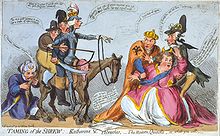Peace of Iassy

The Peace of Jassy is a peace treaty between the Russian Empire and the Ottoman Empire . He was born on December 29, 1791 jul. / January 9, 1792 greg. signed in Jassy, the then capital of the Principality of Moldova (now Iași in Romania ). The treaty ended the sixth Russo-Turkish War from 1787 to 1792.
This had been declared by Sultan Abdülhamid I against Russia in 1787 after the Russians had refused to withdraw from the khanate of Crimea they had annexed and the northern littoral of the Black Sea . During this war the Turks received support from the English side. The Russian Tsarina Catherine II had in turn allied with Austria . The Russian troops, led by Alexander Wassiljewitsch Suvorov , won several victories in the battle with the Turks, including in 1790 the conquest of the fortress of Ismaïl in the Danube Delta , which until then was considered impregnable. After that, Suvorov's army turned towards Constantinople .
In his impossibility to correct the military situation in his favor, was the young Sultan Selim III. forced to seek peace with its European neighbors. He ended the state of war with Austria in the Peace of Swishtow . With Prussian mediation it was now a matter of drafting a Jassy contract that was acceptable to him. At the head of the Russian delegation was Prince Grigory Alexandrowitsch Potjomkin and, after his death on October 16, 1791, Prince Alexander Andreevich Besborodko . The Ottoman Empire was represented by the chief negotiator, Grand Vizier Koca Yusuf Pascha .
In this treaty, the Turkish Empire recognized the annexation of the Crimean Khanate in 1783 under Tsarina Catherine II and the establishment of the city and ship base of Sevastopol by Potjomkin . Russia received the fortress of Ochakov on the right bank of the Dnieper - Bug estuary and all land east of the Dniester , which became the border river. The northern coast of the Black Sea thus became Russian territory.
The Kuban River remained the Caucasian border between the two empires . The fortification in the city of Anapa , built by French engineers in 1781 as a Turkish border fortress, had been captured by the Russians, but was returned after the Peace of Jassy in 1792.
literature
- Hans Uebersberger : Russia's Orient Policy in the Last Two Centuries. Volume 1: Until the Peace of Iassy. Deutsche Verlagsanstalt, Stuttgart 1913, ( Publications of the Society for Modern History of Austria ZDB -ID 568217-4 ).
Web links
- Encyclopaedia Britannica-Online (English)
Individual evidence
- ↑ Turkish Empire . In: Meyers Konversations-Lexikon . 4th edition. Volume 15, Verlag des Bibliographisches Institut, Leipzig / Vienna 1885–1892, p. 927.
- ↑ Russian Empire . In: Meyers Konversations-Lexikon . 4th edition. Volume 14, Verlag des Bibliographisches Institut, Leipzig / Vienna 1885–1892, p. 89.
- ↑ Anapa . In: Meyers Konversations-Lexikon . 4th edition. Volume 1, Verlag des Bibliographisches Institut, Leipzig / Vienna 1885–1892, p. 534.
